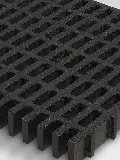loading...
- No. 9, Xingyuan South Street, Dongwaihuan Road, Zaoqiang County, Hengshui, Hebei, China
- admin@zjcomposites.com
- +86 15097380338
- Welcome to visit our website!
frp profiles
Understanding FRP Profiles A Comprehensive Overview
Fiber Reinforced Plastics (FRP) have gained significant attention in various industries due to their unique properties and advantages over traditional materials. FRPs are composite materials made from a polymer matrix reinforced with fibers, which can include glass, carbon, or aramid fibers. This combination enhances the material's strength, durability, and lightweight characteristics, making it an ideal choice for a variety of applications. In this article, we will delve into the different profiles of FRP, their benefits, applications, and future outlook.
What are FRP Profiles?
FRP profiles are specific shapes or forms of FRP materials produced to fulfill particular structural or aesthetic requirements. These profiles can include rods, sheets, beams, and custom shapes tailored for specific applications. The manufacturing process often involves pultrusion, extrusion, or filament winding, allowing for versatility in design and functionality. This adaptability makes FRP profiles suitable for diverse fields, including construction, automotive, aerospace, and marine industries.
Advantages of FRP Profiles
One of the most significant advantages of FRP profiles is their high strength-to-weight ratio. This property enables the creation of lightweight structures without compromising strength, which is particularly important in sectors like aerospace and automotive manufacturing, where reducing weight can significantly improve performance and fuel efficiency.
Additionally, FRP materials are highly resistant to corrosion and environmental degradation. Unlike metals, which can rust or corrode over time when exposed to moisture or chemicals, FRP profiles maintain their integrity in harsh environments. This resistance extends their lifespan and reduces maintenance costs, making them a cost-effective solution in the long run.
Another major benefit is the design flexibility that FRP profiles offer. Engineers can easily shape and mold these materials into complex geometries, allowing for innovative designs that are not feasible with traditional materials. This unique characteristic opens up new possibilities for architects and designers, enabling them to push the boundaries of creativity in construction and manufacturing.
frp profiles

Applications of FRP Profiles
FRP profiles can be found in a wide range of applications. In the construction industry, they are used for creating reinforcement structures, bridge components, and even entire building frames. Their lightweight nature facilitates easy handling and installation, while their durability ensures long-term safety and reliability.
In the automotive sector, FRP is utilized to manufacture lightweight components that can enhance vehicle performance without compromising safety. The use of FRP not only improves fuel efficiency but also contributes to lower greenhouse gas emissions, aligning with the global push towards sustainability.
The aerospace industry is another significant user of FRP profiles, where minimizing weight is paramount. Aircraft components made from FRP can enhance fuel efficiency and improve overall performance, making them a preferred choice for manufacturers.
Future Outlook
The future of FRP profiles looks promising, with ongoing research and advancements in technology likely to enhance their properties even further. Innovations like bio-based resins and recycled fibers may contribute to more sustainable FRP products, catering to the growing demand for environmentally friendly materials. Additionally, as industries increasingly focus on reducing their carbon footprint, the adoption of FRP profiles is expected to rise.
In conclusion, FRP profiles represent a revolutionary advancement in material science, offering multifaceted benefits across various sectors. Their unique properties, combined with their versatility and resistance to harsh environments, make them a preferred choice for contemporary engineering challenges. As technology continues to evolve, FRP profiles are likely to play an ever-expanding role in building a sustainable future.
-
GRP Structures: The Future of Lightweight, High-Performance EngineeringNewsJun.20,2025
-
FRP Water Tank: High-Performance Storage for Corrosive and Clean Water SystemsNewsJun.20,2025
-
FRP Square Tube: The New Industry Standard for Chemical and Structural ApplicationsNewsJun.20,2025
-
FRP Pultruded Profiles: The Ultimate Choice for Lightweight Structural StrengthNewsJun.20,2025
-
FRP Handrails: The Safer, Smarter, and Stronger Choice for Modern InfrastructureNewsJun.20,2025
-
FRP Grating: The Smart Solution for Durable, Lightweight Industrial FlooringNewsJun.20,2025
-
Why Choose a Galvanized Water Tank for Your Storage NeedsNewsMay.21,2025
